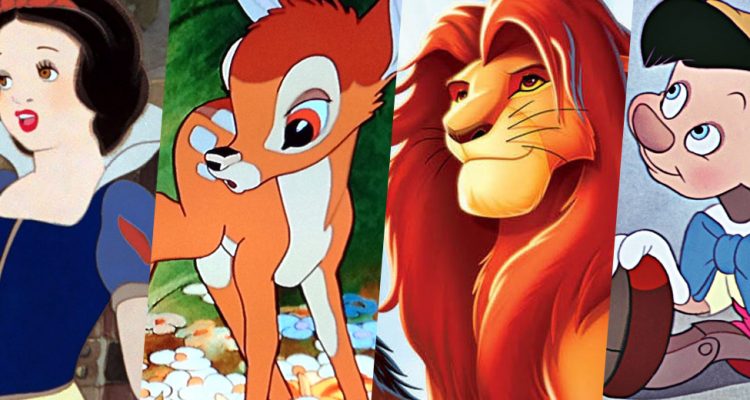Some big boots are attempting to be filled this week. Recent years have seen Disney finding increasing success with live-action reboots of their animated classics, from the billion-dollar, virtually unwatchable “Alice In Wonderland” to last year’s surprisingly strong “The Jungle Book,” with what seems like dozens of new ones in the works, including Guy Ritchie’s “Aladdin” and Jon Favreau’s Donald Glover-starring “The Lion King.”
READ MORE: 10 Films To See In March
But this week sees the release of “Beauty And The Beast,” Bill Condon’s live-action redo of the 1991 Oscar-nominated classic, and it might be the most beloved of these films yet to be attempted. Whether it works or not seems to be in the eye of the beholder (read our review here), but to mark the occasion, we’ve expanded an old post and ranked every one of the 56 films in the official Disney Animated canon from Worst to Best. Take a look below, and tell us how wrong we are in the comments.

56. “Dinosaur” (2000)
A mold-breaker — it was the first computer-animated Walt Disney Feature Animation movie, melding the CGI characters with live-action backgrounds, in the style of BBC series “Walking With Dinosaurs” — this mostly forgotten 2000 picture is also, for all its technological innovations, a total bore. Dull, uninventively designed characters, an uncertain tone and a familiar story all add up to a sense that it’s just a bad “Land Before Time” reboot that the world didn’t need. Even Pixar’s later, similar misfire “The Good Dinosaur” is way better.
55. “Home On The Range” (2004)
The early ’00s might have been the worst period in Disney history, with a string of poorly received box-office flops hitting just as Pixar really hit their stride with films like “Finding Nemo” and “The Incredibles.” The nadir of that time was probably “Home On The Range,” which would prove to be the company’s last 2D movie in five years — a pseudo-Western about a trio of cows (Roseanne Barr, Judi Dench and Jennifer Tilly) trying to catch an outlaw (Randy Quaid). Crude, unsophisticated and visually unspectacular, it’s a film you’ll likely have forgotten by the time it wraps up.
54. “Chicken Little” (2005)
The first entirely CGI-animated Disney film, and the first pic after a regime change that looked to move away from traditional 2D movies, “Chicken Little” turns the classic fable of the chicken who believes the sky is falling into, bafflingly, an alien-invasion movie. With all the aesthetic appeal of a late-’90s Playstation cutscene, and attempting to substitute frantic energy for actual jokes, it’s a headache of a movie, and rightly caused a general rethink of the studio’s approach (though it would take a few years for it to take effect).

53. “Fun & Fancy Free” (1947)
The fourth and final of the so-called “package” films — collections of shorts made on the cheap in order to save costs during and after World War II — this combines two films originally planned as features: “Bongo,” about an escaped circus bear romancing a wild lady bear; and “Mickey And The Beanstalk,” a fairy-tale redo with Mickey as the bean-loving, giant-slaying Jack. They’re fine enough, but pretty rote — “Bongo” is the exact midpoint of “Bambi” and “Dumbo” but without the joy of either, ‘Mickey’ is just too familiar a story to have much fun to it — and the strange live-action segment with ventriloquist Edgar Bergen stops the film dead now.
52. “Brother Bear” (2003)
An attempt to return Disney to the vibe of classic animation tales like “Bambi” or even “The Lion King,” “Brother Bear” is the story of a young Inuit hunter (Joaquin Phoenix, slightly miscast in a role it’s hard to imagine him taking now) who’s transformed into a bear and goes on a journey with a younger cub. There’s some nifty animation going on, and its heart is in the right place, but it feels mostly by-the-numbers and even a little dated (Rick Moranis and Dave Thomas doing Bob & Doug McKenzie as moose for the comic relief is just one example of that).
51. “Make Mine Music” (1946)
The third of the package movies of the 1940s, “Make Mine Music” stuffs in the most storylines, with 10 separate segments, including an adaptation of Prokofiev’s “Peter And The Wolf,” and an odd Hatfield & McCoy-type feud storyline (that’s mostly been removed on subsequent releases due to the gunfighting). Like all anthologies with this many storylines, it’s very hit-or-miss, but there are a couple of good segments — the beautiful “Blue Bayou” (a “Fantasia” outtake, essentially), and oddball closer “The Whale Who Wanted To Sing At The Met.”

